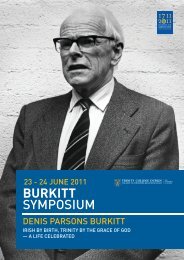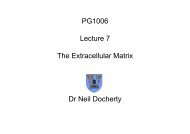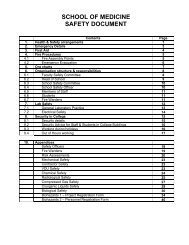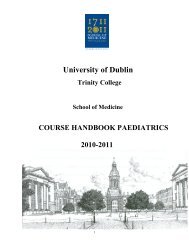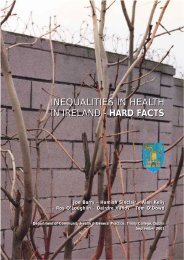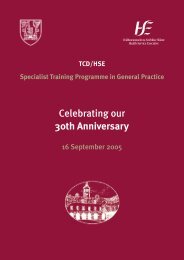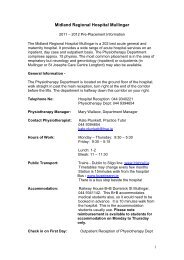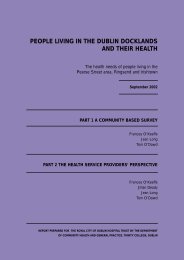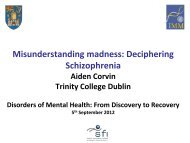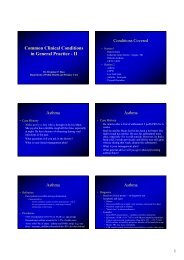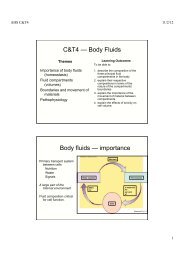student guidebook block 1 - School of Medicine - Trinity College ...
student guidebook block 1 - School of Medicine - Trinity College ...
student guidebook block 1 - School of Medicine - Trinity College ...
- No tags were found...
You also want an ePaper? Increase the reach of your titles
YUMPU automatically turns print PDFs into web optimized ePapers that Google loves.
STUDENT GUIDEBOOKBLOCK 1: INTRODUCTION2010/11pbl <strong>student</strong> handbook <strong>block</strong>1 23/09/2010<strong>School</strong> <strong>of</strong> <strong>Medicine</strong>9/28/2010
© <strong>School</strong> <strong>of</strong> <strong>Medicine</strong>TABLE OF CONTENTSTHE SEVEN STEPS IN PROBLEM BASED LEARNING .................................................................................................................... 5YEAR 1: BLOCK 1 ........................................................................................................................................................................ 6LEARNING OBJECTIVES .......................................................................................................................................................... 6READING LIST: ............................................................................................................................................................................ 6Scenario 1: Secrecy & Power ............................................................................................................................................ 7Scenario 2: Stereotyping & Equality ................................................................................................................................. 8Scenario 3: ‘VIP’ ................................................................................................................................................................ 9Scenario 4: Haemopoiesis ............................................................................................................................................... 10Scenario 5: A Case Study <strong>of</strong> Burns Injury ........................................................................................................................ 11Assessment .............................................................................................................................................................................. 122
© <strong>School</strong> <strong>of</strong> <strong>Medicine</strong>GROUP 1GROUP 2GROUP 3GROUP 4Tutor: Rodrigo GonzalezTutor: Katie RyanTutor: Aileen PattersonTutor: Riffat TanveerTues: ARTS 5040 9-11 amTues: ARTS 3070 9-11amTues: ARTS 3137 9-11amTues: GSH 2A 9-11amFri: ARTS 4046 9-11amFri: ARTS 3070 11-1pmFri: ARTS 5033 11-1pmFri: ARTS 4018 11-1pmNoor Syazana Abd Aziz Siti Lorna Ellen Power Vilen Romanov Jane O'SullivanCharlene Wang Yuki Tanaka Verity Hill Kevin JacobSean Campbell Rebecca Louise Geary Aisling Fagan Jeffrey HoNaomi Mary Dortie Nazik Amdiss Isabel Ann Cornell Iseult BrowneCharlotte Vaughn Ciara Kelly Claire Kruger Eimear KeaneShruti Sebastian Ching Yeung Harvey Ng Conor Prendergast Sile KellyAndrew James Davidson Huijia Wang Ahamad Muhammad Aqeel Gillian CroweFergus Murphy Mary Kate Byrne Constantin Neculai Manole Jennifer DwyerLouise Sweeney Andrew Stokes Mohamed A Magboul M. Stephen SweeneyCharlotte Murphy Sean Tamgumus Micheal O'Riain Conor FeelyBrendan Browne Sinead Costello Charles Julienne Gavin KellyAlan Horan Mary Joyce Georgia Merron Tom BrennanGROUP 5GROUP 6GROUP 7GROUP 8Tutor: Suzan. McCreddinTutor: Daniel NevinTutor: Eimear GleesonTutor: Claire DonohoeTues: SJH TC WHSR 9-11amFri: ARTS 5025 11-1pmTues: ARTS 4084 9-11amFri: SJH TC OSB 00.159-11amTues: SJH TC OSB 00.169-11amFri: SJH TC OSB 00.1511-1pmTues: SJH TC OSB 00.159-11amFri: SJH TC OSB 00.159-11amKunal Mohan Maeve Slevin Matthew Kurt Hainbach Claire Ann MacSweeneyRobert Iain Irvine Eabha Manley Biruthvi Vignarajah Peter WuAndrew Stokl Cassandra Stiller-Moldovan Sayna Bahrani Robert OwensHan Yang (Peter) Khiew Sinead Keohane Muhammd Syauqan Zaini Sarah PetchSean Kelley Marie Boland Muhammad Syahir Mohd Neil MartinAaron Augustine Chai Robyn Mary Poole David Cooper Muhammad Syafiq MohdAnna Tierney Abdirahman Mohamed Siobhan Walsh Dmitry BakshunCiara Ottewill Neasa Fitzpatrick Claire Cullen Owen Martin ThorpeJohn Flanagan Megan Carlson Orla O'Dwyer Juman SaarahHishaam Saumtally Sophia Angelov Paul Riordan Lorcan CooperCaoimhe Brennan Atikah Nur Dzulkhefli Garret James O'Connell Rebecca MawhinneySinead Ramjit Wen Hao Tan Karen Lesley Mackey Conor Hickie3
© <strong>School</strong> <strong>of</strong> <strong>Medicine</strong>GROUP 9GROUP 10GROUP 11GROUP 12Tutor: Gary SommervilleTutor: Rus. McLaughlinTutor: Charlotte CallaghanTutor: Neil FlemingTues: WHSR 11-1pmTues: ARTS 3071 11-1pmTues: ARTS 4046 11-1pmTues: ARTS 3069 11-1pmFri: GSH 2A 9-11amFri: ARTS 3071 9-11amFri: ARTS 4045 9-11amFri: ARTS 4084 9-11amStephen Ludgate Kristen Maunder Christopher Ma Rachel MullalyCatherine King Kate Doyle Kris Hughes Daire James RothwellNurul Hafizah Zailani Orlagh Deighan Arif Qaedi Choo Conor ToaleJennifer Collins Kerry McGlynn Lakshman Kumar Melanie Lang-OrsiniArthur Lau Adam Lee Adam Boissonneault Laura McLoughlinCiara Drumm Aisling Barrett Emma McNally Sinead ClearyCatherine Drislane Bryan Traynor Christopher McAteer Alana McEvoyHazel Marie O'Neill Aimee McGreal-Bellone Kevin O'Rourke Andrew BarryMaria Redahan Edwin Chu Meg McNicholas Brian WoodsConor McGarrigle Caroline Walker Patrick Richard Jordan Robert FleckHauwa Balami Isabelle Hunt Leonidas Constantinides Luke MoseleyMaria Floriana Latan Thomas James Matthews Vincent Ngo Fiona LynottGROUP 13Tutor: Amy BirchTues Goldsmith Hall 2A11-1pmFri ARTS 3069 9-11amRiona WalshNur Afiqah KamaruddinMohamed Magzoub Els.Michael McCrohanSean McGivernEnala AsajileEleanor O'DriscollElinor JenkinsAnna BrownAmy Louise NashJordan McGarryAodhbha SchuttkeGROUP 14Tutor: Lynda McEvoyTues: SJH TC OSB 0.1611-1pmFri: SJH TC OSB 0.16 9-11amMohd Nuruddin MuhamadRobert SuttieBenedict Michael BlunnieJack O'KennedyWassim MoslehNicholas GavinRachel MulpeterShannon ClearyJoseph KeladaJohn MathesonJean LowrySJH – Saint James HospitalGSH – Goldsmith HallTC – <strong>Trinity</strong> CentreWHSR – William Hayes Seminar RoomARTS – Arts Building, TCDOSB – Old Stone Building*Old Stone Building <strong>Trinity</strong> Centre - StJames’s Hospital Dublin 8*WHRS – William Hayes Seminar Room<strong>Trinity</strong> Centre - St James Hospital Dublin 8*ARTS – ARTS <strong>block</strong> <strong>Trinity</strong> <strong>College</strong> oncampus4
© <strong>School</strong> <strong>of</strong> <strong>Medicine</strong>THE SEVEN STEPS IN PROBLEM BASED LEARNING(THE “SEVEN JUMP” METHOD)1. Clarify any terms and concepts that are unclear in the problem2. Define the problem, i.e. list the phenomena to be explained OR write “Problem statements”3. Explain the problem using prior knowledge and common sense to produce as many possibleexplanations as possible (“brainstorming”)4. Arrange the explanations to form a coherent description <strong>of</strong> the processes that seem tounderlie the phenomena5. Formulate learning goals6. Fill the knowledge gaps through individual study7. Share the findings in a group discussion and integrate the knowledge into a comprehensiveexplanation <strong>of</strong> the phenomena (i.e. “solve the problem”)5
© <strong>School</strong> <strong>of</strong> <strong>Medicine</strong>YEAR 1: BLOCK 1LEARNING OBJECTIVESAIMS: The aim <strong>of</strong> this <strong>block</strong> is to introduce <strong>student</strong>s to the process <strong>of</strong> Small Group Tutorial whichincludes working in groups, identifying gaps in knowledge, deriving learning goals and self directedlearning.OBJECTIVES:Students should be able to:discuss a scenario following the seven step methodconsider aspects <strong>of</strong> power systems and the how secrecy and can be used to influence poweroutline the legislation that exists to prevent discriminationdiscuss the difference between ‘equality’ by treating everyone the same, and a concept <strong>of</strong>equality which recognises differences and accommodates diversity and reasonableaccommodation <strong>of</strong> special needs (eg disability)describe the primary, secondary, tertiary and quaternary structures <strong>of</strong> proteinsoutline the process <strong>of</strong> blood cell formationlist the lifespan <strong>of</strong> the different blood cellsdescribe cutaneous nerve supply <strong>of</strong> foot and lower limbreview fluid compartmentsoutline the process <strong>of</strong> acute inflammationREADING LIST:http://www.tcd.ie/equality/http://www.tcd.ie/equality/pdf/employment_equality1998_2004.pdfEssential cell biology / Bruce Alberts ... [et al.]. 574.87 N82 (TCD library)Dr. Tuffrey’s notes on blood can be found at:http://www.medicine.tcd.ie/physiology/assets/docs/handbooks/AllMedSciManual08.pdfStep up to <strong>Medicine</strong>: Agabegi and Derby or any other clinical medicine textbook.6
© <strong>School</strong> <strong>of</strong> <strong>Medicine</strong>SCENARIO 1: SECRECY & POWERBrian, a 3 rd year med <strong>student</strong>, is sitting on the tram considering the events <strong>of</strong> the past week. It hasbeen a peculiar week. He is reading the latest political scandal about the abuse <strong>of</strong> Minister’s powersto secure funding for a Health Service contract for his nephew. This infuriates him as it is such a waste<strong>of</strong> money that could be used for frontline services. He’s already seen that the staff at his hospital areunable to cope with the increased inpatient demands due to the staff moratorium.He thinks about how his friend has taken a prescription pad and is prescribing the latest upper to helpwith studying. Lots <strong>of</strong> his classmates are taking it and so he feels he should not be at a disadvantage.After all it is only for the exams, he’s not going to become a junkee.He is worried that he has seen his friend prescribing methadone to help people come down and thisjust seems a bridge to far.Thankfully, he is going to meet with an old school friend, whom he can confide in.Learning Goals___________________________________________________________________________________________________________________________________________________________________________________________________________________________________________________________________________________________________________________________________________________________________________________________________________________________________________________________________________________________________________________________________________________________________________________________________________________________________________________________________________________________________________________________________________________________________________Consensus___________________________________________________________________________________________________________________________________________________________________________________________________________________________________________________________________________________________________________________________________________________________________________________________________________________________________________________________________________________________________________________________________________________________________________________________________________________________________________________________________________________________________________________________________________________________________________7
© <strong>School</strong> <strong>of</strong> <strong>Medicine</strong>SCENARIO 2: STEREOTYPING & EQUALITYDr. Jones has gone to a recruitment company looking for a receptionist.He is asked what characteristics he would like the successful candidate to have.Dr. Jones says he thinks that an older woman who has raised her family would be suitable. In generalhe has employed young women but they need maternity leave and it is bothersome arranging cover.He once had a male temp from the inner city but patients had difficulty understanding his accent andhe worried that he may only have taken the job so he could get access to drugs. He just wantssomeone normal with good manners.Learning Goals___________________________________________________________________________________________________________________________________________________________________________________________________________________________________________________________________________________________________________________________________________________________________________________________________________________________________________________________________________________________________________________________________________________________________________________________________________________________________________________________________________________________________________________________________________________________________________Consensus___________________________________________________________________________________________________________________________________________________________________________________________________________________________________________________________________________________________________________________________________________________________________________________________________________________________________________________________________________________________________________________________________________________________________________________________________________________________________________________________________________________________________________________________________________________________________________8
© <strong>School</strong> <strong>of</strong> <strong>Medicine</strong>SCENARIO 3: ‘VIP’The word protein comes from Greek and means <strong>of</strong> ‘first importance’. In humans, proteins constitutemore than 50% <strong>of</strong> the dry weight <strong>of</strong> the cell. They are highly diverse and dynamically functional, someare enzymes, some are hormones, some have important transport functions in cell membranes andbody fluids and some are antibodies. The diversity <strong>of</strong> function derives from structural difference yetevery protein is built from a repertoire <strong>of</strong> 20 amino acids, therefore it is the sequencing and folding <strong>of</strong>these amino acids, resulting in the final conformation <strong>of</strong> the protein which makes the wide range <strong>of</strong>functions possible. Discuss protein structure and list some examples <strong>of</strong> proteins.Learning Goals___________________________________________________________________________________________________________________________________________________________________________________________________________________________________________________________________________________________________________________________________________________________________________________________________________________________________________________________________________________________________________________________________________________________________________________________________________________________________________________________________________________________________________________________________________________________________________Consensus___________________________________________________________________________________________________________________________________________________________________________________________________________________________________________________________________________________________________________________________________________________________________________________________________________________________________________________________________________________________________________________________________________________________________________________________________________________________________________________________________________________________________________________________________________________________________________9
© <strong>School</strong> <strong>of</strong> <strong>Medicine</strong>SCENARIO 4: HAEMOPOIESISThe haematologist is reviewing Mr Stoker’s case. He has been complaining <strong>of</strong> feeling increasingly tiredfor the past 12 months. The blood film shows macrocytic anaemia, she wondered if the patient’s B12had even been checked yet!Just then, she receives at an urgent blood film, the information on the request stated that “thepatient was tired and bruising easily, query cause”.The blood film showed red blood cells were decreased; platelet count was low and there werecirculating myeloblasts. She books an urgent bone marrow trephine and aspiration, she prefers totake this from the iliac crest.Learning Goals___________________________________________________________________________________________________________________________________________________________________________________________________________________________________________________________________________________________________________________________________________________________________________________________________________________________________________________________________________________________________________________________________________________________________________________________________________________________________________________________________________________________________________________________________________________________________________Consensus___________________________________________________________________________________________________________________________________________________________________________________________________________________________________________________________________________________________________________________________________________________________________________________________________________________________________________________________________________________________________________________________________________________________________________________________________________________________________________________________________________________________________________________________________________________________________________10
© <strong>School</strong> <strong>of</strong> <strong>Medicine</strong>SCENARIO 5: A CASE STUDY OF BURNS INJURYA 70 year old male with long-term diabetes attends the burns clinic with second degree burns afterscalding his lower left leg and foot in a hot bath which his son has run for him. The lower limb ispainful, swollen and blistered. The patient receives an acute treatment with prophylactic topicalantibiotic (silver sulfadiazine), gauze dressing and i.v normal saline (0.9% NaCl).Learning Goals___________________________________________________________________________________________________________________________________________________________________________________________________________________________________________________________________________________________________________________________________________________________________________________________________________________________________________________________________________________________________________________________________________________________________________________________________________________________________________________________________________________________________________________________________________________________________________Consensus___________________________________________________________________________________________________________________________________________________________________________________________________________________________________________________________________________________________________________________________________________________________________________________________________________________________________________________________________________________________________________________________________________________________________________________________________________________________________________________________________________________________________________________________________________________________________________11
© <strong>School</strong> <strong>of</strong> <strong>Medicine</strong>TYPES OF ASSESSMENTASSESSMENTFormative: provides <strong>student</strong>s with information about their skills and achievements, end <strong>of</strong> week or mid-<strong>block</strong>.Summative: to record tutor’s judgements about <strong>student</strong> progress, end <strong>of</strong> <strong>block</strong>.ASSESSMENT PROCESSThere are three tenets to <strong>student</strong> self-assessment: Preparation, Participation and Pr<strong>of</strong>essional Behaviour.Students should reflect on how they performed in each area before reporting a self-assessment mark.Reiterate the learning outcomes for their participation in the small group learning tutorials.These are as follow:to promote knowledge integrationto practice and develop analytical skillsto demonstrate information management skillsto demonstrate effective team working and leadership skillsto communicate effectivelyto identify their own learning needs to promote pr<strong>of</strong>essional behavioursPREPARATIONIs familiar with the content <strong>of</strong> basic references e.g., recommended texts and readingsContributes mainly from the head (rather than reading from notes or texts)Illustrates concepts with specific examplesIdentifies when help is needed from the group to understand problematic material (and to formulateuseful questions to ask)Gets beyond the basic texts, lectures and readings to learn the 'depth' from primary literature andother sourcesKnows about uncertainties and controversyAnalyzes multiple sources <strong>of</strong> information and synthesizes conclusions and new questionsIntegrates knowledge across organization levels (e.g., molecular, cellular, microscopic, gross, individual,family, community) and explains clinical phenomena with knowledge and concepts from basic medicaland social sciences; attends to bio-psycho-social issuesPARTICIPATIONContributes actively, regularly and substantially to the learning groupDraws diagrams, flow charts and tables to explain, explore and summarizeDemonstrates and improves skills in the PBL tutorial process and sequence, i.e., identify problems,develop hypotheses, develop mechanisms, develop learning issues, critically assess informationDemonstrates active listening skills, e.g., summarizing, identifying circular arguments and omissionsUses evidence and states the sources and assesses the quality <strong>of</strong> that evidenceFacilitates participation <strong>of</strong> othersEngages in (and initiates) assessment, goal-setting and monitoring for self and the groupCritically assesses and challenges others' concepts and ideas in a logical and constructive way12
© <strong>School</strong> <strong>of</strong> <strong>Medicine</strong>PROFESSIONAL BEHAVIOURIs present, on time and well preparedConsistently demonstrates kindness, caring, acceptance <strong>of</strong> responsibility, honesty and fairnessIs courteous, respectful and sensitive to the learning needs <strong>of</strong> others and the group as a wholeAttends to good functioning <strong>of</strong> the group and modulates personal behaviour to promote thisExplains and discusses using terminology that is correct for medicine/dentistry and also in plainlanguage that is clear for patientsIs knowledgeable about, and demonstrates the application <strong>of</strong> ethical principlesAccurately identifies areas <strong>of</strong> personal strength and weakness and sets goals for improvementDemonstrates self-awareness and discloses feelings and valuesGives and receives feedback with skill and useful outcomesEnd <strong>of</strong> Week AssessmentAt the end <strong>of</strong> each week there should be an allotted 10-15 minutes to discuss any group, individual, <strong>block</strong> ortutor issues. This may include what has gone well and what the group or individuals could improve for futureweeks.Mid-Block AssessmentStudent performance should be evaluated more formally mid-<strong>block</strong>. Students should be asked to self evaluatetheir performance during the week and what they consider their strengths and weaknesses to be.Tutors should allow 10-15 minutes for the self assessment process. If the tutor does not agree with the<strong>student</strong>’s evaluation he/she should discuss it with the <strong>student</strong>. There should be no surprises for the <strong>student</strong> ifthe tutor does not believe they are performing well.End <strong>of</strong> Block AssessmentTutors should request and receive each <strong>student</strong>’s completed self assessment form one week prior to the end <strong>of</strong>the <strong>block</strong>. The tutor may write comments to provide feedback and will sign the form to indicate that it hasbeen reviewed. The forms are returned to the <strong>student</strong>s for their personal records.The final tutor assessment will assign an overall grading as well as one rating for Preparation, Participation andPr<strong>of</strong>essional Behaviour.The grades are:F = DOES NOT MEET REQUIREMENTS,P-= REQUIRES IMPROVEMENTS,P= MEET REQUIREMENTS.H= Honours may be used for formative purposes only.Students who attain full attendance and S grades will achieve the maximum 5%.13
© <strong>School</strong> <strong>of</strong> <strong>Medicine</strong>The <strong>School</strong> <strong>of</strong> <strong>Medicine</strong>, <strong>Trinity</strong> <strong>College</strong> DublinPBL Tutorial – Student Self-AssessmentThis document must be shared with (and initialled by) the tutor. Keep the original in your Self-Assessment Folder. Do this before the last week <strong>of</strong> the <strong>block</strong>.Purpose: to facilitate an understanding between you (the <strong>student</strong>) and your tutor about your view <strong>of</strong>personal strengths, weaknesses and goals. It asks you to reflect on progress and change, preferablyshared with the tutorial group (reality check). It also helps your tutors to validly asses your ability andprogress in the skills <strong>of</strong> self-assessment.Keep in mind the PBL tutorial evaluation categories: Preparation – Participation – Pr<strong>of</strong>essionalbehaviour and associated skills. Be specific and descriptive. You may alter it after discussion with thetutor and/or tutorial group.Student: ________________________________ Date: ____________________________Block: __________________________________ Tutor: ___________________________The most useful feedback I have received and/or insight(s) I have had:My strength(s) and most importantly change(s) since the last <strong>block</strong>:My goal(s) and plan(s):Additional comments may be attached or written overleaf.14
© <strong>School</strong> <strong>of</strong> <strong>Medicine</strong>The <strong>School</strong> <strong>of</strong> <strong>Medicine</strong>, <strong>Trinity</strong> <strong>College</strong> DublinPBL Tutor Assessment <strong>of</strong> StudentComplete this form for each <strong>student</strong> in your group. Give a copy to the <strong>student</strong> and a copy to the <strong>School</strong> <strong>of</strong> <strong>Medicine</strong> Office.Submit Year forms to Gillian Barden in the school <strong>of</strong>fice.Student: ____________________________ Tutor: ____________________________Block: ______________________________ Block Dates: _______________________Number <strong>of</strong> absences : ___(<strong>School</strong> to complete) No. <strong>of</strong> Excused Absences for this Student: ___ No. <strong>of</strong> unexcused absences: ___Record your ‘global’ (overall) rating <strong>of</strong> this <strong>student</strong>’s performance in tutorials. Make this judgement with reference to theperformance criteria <strong>of</strong> three skills areas: Preparation, Participation, and Pr<strong>of</strong>essional behaviour (see Tutor manual fordescription <strong>of</strong> each area). Please discuss your evaluation feedback with the <strong>student</strong>. (Note: ‘H’ cannot be used for globalrating, but may be awarded for specific skills areas)Global Rating: F does not meet requirements (P-) requires improvement P meets requirementsDetailed Evaluation: Use the scale: F, (P-), P, H to rate and comment on the strengths and weaknesses in each skill area.Include, if relevant, the group context for <strong>student</strong>’s performance and append additional comments. Mark P- ratings inbrackets: (P-)Rating: F / (P-) / P / H___ Preparation___ Participation___ Pr<strong>of</strong>essional BehaviourSpecific recommendations to guide <strong>student</strong>’s improvementTutor’s Signature: ___________________Date: ___________________15



